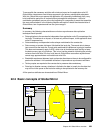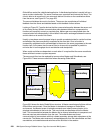
254 IBM System Storage DS6000 Series: Copy Services with IBM System z
Global Mirror works like a distributed application. A distributed application is usually built on a
server to client relationship. The server functions as a supervisor and instructs the client. The
client is able to do some work in an autonomic fashion but relies on the coordination efforts
from the server; see Figure 22-7 on page 253.
The server distributes the work to its clients. The server also coordinates all individual
feedback from the clients and decides based on this feedback further actions.
Looking at Figure 22-7 results obvious that the communication paths between the server and
all its clients are key. Without communication paths between these four components the
functions will eventually come to a complete stop. Matters get more complicated when the
communication fails unexpectedly in the middle of information exchange between the server
and his clients or to some of his clients.
Usually a two-phase commit process helps to provide a consistent state for certain functions
and whether they have successfully completed at the client site. Once a function is
successfully completed and is acknowledged to the server, the server progresses to the next
function task. At the same time the server tries to do as much as possible in parallel to
minimize the hit on throughput due to serialization and checkpoints.
When certain activities are dependent on each other it is required that the server coordinate
these activities to ensure a proper sequence.
The server and client can be replaced by terms such as Master and Subordinate; see
Figure 22-8. These terms are used later when discussing Global Mirror.
Figure 22-8 Global Mirror as a distributed application
Figure 22-8 shows the basic Global Mirror structure. A Master coordinates all efforts within a
Global Mirror environment. Once the Master is started and manages a Global Mirror
environment, the Master issues all related commands over inband communication to its
attached subordinates at the local site. This may include a subordinate within the Master
itself. This communication between the Master and an internal subordinate is transparent and
does not need any extra attention from the user. The subordinates use inband
communication to communicate with their related secondary storage disk subsystems at the
remote site. The Master also receives all acknowledgements from his subordinates and their
secondaries, and coordinates and serializes all the activities in the session.
Remote site
Local site
Master
Subordinate
Secondary
Secondary
Network
Subord Flash Sec
FlashCopy2
Primary
Primary


















